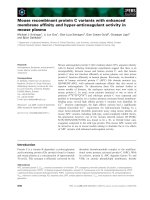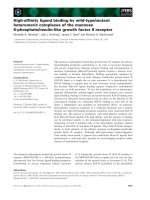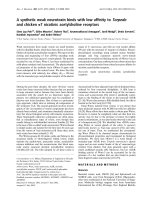airFiber AF 5XHD QSG
Bạn đang xem bản rút gọn của tài liệu. Xem và tải ngay bản đầy đủ của tài liệu tại đây (6.13 MB, 28 trang )
LINK
GPS
MGMT
DATA
5 GHz Carrier Radio
with LTU Technology
DATA
MGMT
Model: AF-5XHD
GPS
LINK
Introduction
Thank you for purchasing the Ubiquiti Networks® airFiber®
AF-5XHD. This Quick Start Guide is designed to guide you
through installation. Warranty terms, safety notices, and
compliance information are in the airFiber AF-5XHD User
Guide, available at: www.ubnt.com/download/airfiber
Package Contents
airFiber
AF-5XHD
Metal Strap
GPS Antenna
Mount
Zip Ties
(Qty. 2)
Universal
Bracket
External GPS
Antenna
IP67 Upgrade Kit
(Vent and Gasket)
LINK
GPS
MGMT
DATA
5 GHz Carrier Radio
with LTU Technology
DATA
MGMT
Model: AF-5XHD
Gigabit PoE (24V, 1A)
with Mounting Bracket
Power Cord
GPS
LINK
AF-5XHD
Quick Start Guide
TERMS OF USE: Ubiquiti radio devices must be professionally installed. Shielded Ethernet
cable and earth grounding must be used as conditions of product warranty. TOUGHCable™ is
designed for outdoor installations. It is the professional installer’s responsibility to follow local
country regulations, including operation within legal frequency channels, output power, and
Dynamic Frequency Selection (DFS) requirements.
Antenna Compatibility
The airFiber AF-5XHD radio is designed for use with the
following airFiber X antenna models:
• AF-5G23-S45
• AF-5G30-S45
• AF-5G34-S45
The AF-5XHD can also operate with the following RocketDish™
antenna models:
• RD-5G30*
• RD-5G34*
* Requires Universal Bracket (included) or AF-5G-OMT-S45 Conversion Kit
(not included).
Installation Requirements
•
•
•
•
Clear line of sight between airFiber radios
Clear view of the sky for proper GPS operation
Vertical mounting orientation
Mounting point:
• At least 1 m below the highest point on the structure
• For tower installations, at least 3 m below the top of
the tower
• Ground wires – min. 10 AWG (5 mm2) and max. length:
1 m. As a safety precaution, ground the airFiber radio to
grounded masts, poles, towers, or grounding bars.
WARNING: Failure to properly ground your
airFiber radio will void your warranty.
• (Recommended) 2 Outdoor Gigabit PoE surge protectors
Note: For guidelines about grounding and lightning
protection, follow your local electrical regulatory
codes.
• Outdoor, shielded Category 6 (or above) cabling and
shielded RJ-45 connectors are required for all wired Ethernet
connections.
Hardware Overview
Chain 0: Connects to
+ 45° on
airFiber Antenna
Connects to
External GPS
Antenna
LED
Panel
Port Cover
Chain 1: Connects to
- 45° on
airFiber Antenna
Ports
Management
Port
Reset
Button
Data
Port
Management Port 10/100/1000 Mbps, secured Ethernet
port for configuration. In-Band Management is enabled by
default in the airFiber Configuration Interface. When In-Band
Management is disabled, the MGMT port is the only port that
can monitor, configure, and/or update firmware. This port can
also be used to provide redundant PoE power.
Reset Button To reset to factory defaults, press and hold the
Reset button for more than 10 seconds while the device is
powered on.
Data Port Gigabit PoE port for handling all user traffic and
powering the device. Default IP address: 192.168.1.20
LEDs
Signal LEDs
Signal 4 LED will light blue when on.
Signal 3 LED will light green when on.
Signal 2 LED will light yellow when on.
Signal 1 LED will light red when on.
Bootup to airOS When powering on, the Power, GPS, Link, and
Signal 1-4 LEDs light on. Once the CPU code takes over, the
GPS, Link, and Signal 1-3 LEDs turn off. The Signal 4 LED remains
on to indicate the boot sequence is underway.
Initializing airFiber Software When the airFiber application
begins to boot under airOS®, the Signal 4 LED goes from
solidly on to a 2.5 Hz flash. This continues until the AF-5XHD
is fully booted.
Signal Level Once fully booted, the Signal 1-4 LEDs act as a
bar graph showing how close the AF-5XHD is to ideal aiming.
This is auto-scaled based on the link range, the antenna gains,
and the configured TX power of the remote AF-5XHD. Each
Signal LED has three possible states: On, Flashing, and Off. All
Signal LEDs would be solidly on in an ideal link. If the link has a
1 dB loss, the Signal 4 LED will flash; a 2 dB loss and the Signal 4
LED will turn off. The full bar graph LED states are shown below.
dB
loss
0
-1
-2
-3
-4
-5
-6
-7
-8
-9
-10 -11 -12 -13
1
F
0
0
0
0
0
0
0
0
0
0
0
0
1
1
1
F
0
0
0
0
0
0
0
0
0
0
1
1
1
1
1
F
F
0
0
0
0
0
0
0
1
1
1
1
1
1
1
1
1
1
F
F
F
0
0 = Off, 1 = On, F = Flashing
Additional LEDs
LED
Link
GPS
State
Status
Off
RF Off
Short Flash*
Syncing
Normal Flash*
Beaconing
Long Flash*
Registering
On
Operational
Off
No GPS Synchronization
Normal Flash*
Non-Operational (Weak Signal)
On
Operational (Strong Signal)
Off
No Ethernet Link
MGMT On
Data
Ethernet Link Established
Random Flash
Ethernet Activity
Off
No Ethernet Link
On
Ethernet Link Established
Random Flash
Ethernet Activity
Off
No Power
On
Powered On
*
Short Flash (1:3 on/off cycle)
Normal Flash (1:1 on/off cycle)
Long Flash (3:1 on/off cycle)
Installation Overview
We recommend that you configure your paired AF-5XHD
radios before site installation. The overview below summarizes
the installation procedure, and the subsequent sections
provide detailed installation information.
• Connect the airFiber PoE Adapter to the Data port, and
connect your computer to the MGMT port.
• Configure the AF-5XHD.
• Recommended: Install the IP67 Upgrade Kit (included) to
prevent intrusion by water, dust, and insects.
• Install a ground wire and mount the AF-5XHD on an
airFiber X or RocketDish antenna.
• At the installation site, install the airFiber X or RocketDish
antenna with the mounted AF-5XHD radio (see the antenna’s
Quick Start Guide for installation instructions).
• Secure the ground wire and mount the GPS antenna.
• Establish and optimize the RF link.
Connecting Power over Ethernet
1. Lift the release latch on the bottom of the AF-5XHD and
slide the Port Cover off.
2. Connect an Ethernet cable to the Data port.
3. Connect the Ethernet cable from the Data port of the
AF-5XHD to the POE port of the adapter.
WARNING: Use only the included adapter, model
POE‑24V‑5X-HD. Failure to do so can damage the
unit and void the product warranty.
4. Connect the Power Cord to the adapter’s power port.
Connect the other end of the Power Cord to a power outlet.
airFiber Configuration
The instructions in this section explain how to access the
airFiber Configuration Interface and configure the following
settings:
• Wireless Mode Configure one AF-5XHD as the Master and
the other as the Slave.
• Frequency Setting The operating Frequency must be the
same on both the Master and the Slave.
1. Connect an Ethernet cable from your computer to the
MGMT port on the AF-5XHD.
2. Configure the Ethernet adapter on your computer with a
static IP address on the 192.168.2.x subnet.
3. Launch your web browser. Type http://192.168.2.20 in the
address field and press enter (PC) or return (Mac).
http://192.168.2.20
4. The login screen will appear. Enter ubnt in the Username
and Password fields. Select your Country and Language.
You must agree to the Terms of Use to use the product.
Click Login.
Note: U.S. product versions are locked to the U.S.
Country Code to ensure compliance with FCC
regulations.
5. Click the Wireless tab.
6. Configure the Basic Wireless Settings:
a. For one AF-5XHD, select Master as the Wireless Mode.
For the other AF-5XHD, select Slave as the Wireless
Mode.
b. Enter a name in the Link Name field. This should be the
same on both the Master and the Slave.
c. Select your Country.
Note: U.S. product versions are locked to the U.S.
Country Code to ensure compliance with FCC
regulations.
d. If needed, change the Channel Bandwidth, Frequency,
Output Power (EIRP), Antenna Gain, and Max TX
Modulation settings. The Channel Bandwidth and
Frequency should be the same on both the Master and
the Slave.
7. Configure the Wireless Security:
a. Select AES-256 for the Security mode.
b. Select PSK for the Authentication mode.
c. In the Key field, enter a combination of alphanumeric
characters (0-9, A-Z, or a-z).
Note: Only ASCII mode is supported.
8. Click Save Changes.
9. Configure each airFiber radio with a unique IP address for
the Data port:
a. Click the Network tab.
b. For both the Data IP Address and Management IP
Address options:
-- DHCP Have your router use DHCP reservation to
assign a unique IP Address.
-- Static Change the IP Address, Netmask, and other
settings to make them compatible with your
network.
c. Click Save Changes.
Repeat the instructions in the airFiber Configuration section on
the other AF-5XHD radio.
For details on the airFiber Configuration Interface, refer to the
airFiber AF-5XHD User Guide, available at:
www.ubnt.com/download/airfiber
You can also manage your device using the Ubiquiti® Network
Management System. The UNMS™ app lets you configure,
monitor, upgrade, and back up your devices using a single
application and can be downloaded from the App Store® (iOS)
or Google Play™ (Android).
Upgrade for IP67 Compliance
To protect the AF-5XHD from intrusion by water, dust, and
insects, we recommend installing the IP67 Upgrade Kit
(included) as instructed below:
1. Remove the tether from the radio and from the Port Cover.
Removing the Tether from the Radio
Post
Removing the Tether from the Port Cover
Note: Do not damage or remove the post on the
Port Cover.
2. Remove the Vent and Gasket from their protective bag.
Peel the Vent off of its backing and place the Vent on the
Tether Slot, ensuring that it covers the slot completely.
Tether Slot
Vent
(adhesive
on back)
3. Attach the Gasket lanyard to the post on the Port Cover.
Lanyard
Post
4. Insert the Gasket into the AF-5XHD, ensuring that it fits
securely in place to form a tight seal.
Hardware Installation
Install a Ground Wire
1. Remove the nut from the Ground Bonding Point located on
the back of the AF-5XHD.
Ground
Bonding
Point
2. Attach a ground wire (min. 10 AWG or 5 mm2) to the lug
and replace the nut to secure the wire.
3. At the installation site, secure the other end of the ground
wire to a grounded mast, pole, tower, or grounding bar.
WARNING: Failure to properly ground your
airFiber radio will void your warranty.
Note: The ground wire should be as short as
possible and no longer than one meter in length.
*640-00338-05*
640-00338-05
Mount to an airFiber X Antenna
Follow the instructions in this section to mount the AF-5XHD
to an airFiber X antenna or to a RocketDish antenna equipped
with the AF-5G-OMT-S45 Conversion Kit.
Note: To mount the AF-5XHD to a RocketDish using the
included Universal Bracket, see the Mount to a RocketDish
Antenna section.
The airFiber X antenna AF‑5G23-S45 is shown in this section:
1. Attach the airFiber X radio to the antenna by aligning the
four tabs on the back of the radio with the slots of the radio
mount. Then slide the radio down to lock it into place.
2. Attach the RF connectors to the radio in this combination:
+45° to Chain 0 and -45° to Chain 1. Then slide the jackets
over the RF connectors to protect them.
3. Attach the external GPS antenna (included with the radio)
to the RF connector labeled GPS on the radio.
4. Attach the Protective Shroud by sliding it down over the
radio until it locks into the radio mount.
Mount to a RocketDish Antenna
Note: If you are mounting the AF-5XHD on a RocketDish
equipped with the AF-5G-OMT-S45 Conversion Kit, the
Universal Bracket is not needed. Refer instead to the
Mount to an airFiber X Antenna section for instructions.
The RocketDish RD‑5G30 antenna is shown in this section:
1. Position the Universal Bracket over the back of the AF-5XHD
with the bracket clips over the AF-5XHD mounting tabs.
2. Push the bracket onto the AF-5XHD until it locks in place.
3. Attach the AF-5XHD to the RocketDish mounting bracket.
a. Align the mounting tabs on the Universal Bracket with
the RocketDish mounting bracket.
b. Slide the AF-5XHD down to lock it into place.
Mount the External GPS Antenna
Locate a mounting point that has a clear view to the sky, and is
above and as far away as possible from the AF-5XHD.
1. Attach the GPS Antenna Mount to the pole using the Metal
Strap, or attach it to a wall using the appropriate fasteners
(not included).
2. Place the External GPS Antenna on the mount.
3. Secure the cable of the External GPS Antenna to the mount
with a Zip Tie.
Connecting Power over Ethernet
1. Lift the release latch on the bottom of the AF-5XHD and
slide the Port Cover off.
2. Connect an outdoor, shielded Ethernet cable to the
Data port.
Note: If the IP67 Upgrade Kit is installed, first apply
dielectric grease to the connector and port.
Dielectric
grease
3. Connect the Ethernet cable from the Data port of the
AF‑5XHD to the POE port of the adapter.
WARNING: Use only the included adapter, model
POE‑24V‑5X-HD. Failure to do so can damage the
unit and void the product warranty.
4. Connect an Ethernet cable from your LAN to the adapter’s
LAN port.
5. Connect the Power Cord to the adapter’s power port.
Connect the other end of the Power Cord to a power outlet.
Mount the PoE Adapter (Optional)
1. Remove the Mounting Bracket from the adapter, place the
bracket at the desired location, and mark the two holes.
2. Pre-drill the holes if necessary, and secure the bracket
using two fasteners (not included).
3. Align the adapter’s slots with the tabs of the Mounting
Bracket, and then slide the adapter down.
Surge Protection
For added protection, install two surge suppressors, such as
the Ubiquiti Ethernet Surge Protector, model ETH-SP, at the
end of each link. Install the first surge protector within one
meter of the airFiber Data port, and install the second surge
protector at the ingress point of the location housing the
wired network equipment.
GPS Antenna
Max. 1 m
AF-5XHD
Mounted on
AF-5G23-S45
ETH-SP
Ground to Pole, Tower,
or Grounding Block:
Max. 1 m from AF-5XHD
EdgeRouter™
ETH-SP
airFiber
PoE Adapter
Power Source
Alignment
Tips
• To accurately align the airFiber radios for best performance,
you MUST align only one end of the link at a time.
• You may need to use additional hardware to compensate for
issues such as the improper orientation of a mounting pole
or significant elevation differences between airFiber radios.
Establishing a Link
Adjust the positions of the Master and the Slave to establish
a link. The following section features the airFiber X antenna,
AF‑5G23‑S45:
Note: The Master must be aimed first at the Slave because
the Slave does not transmit any RF signal until it detects
transmissions from the Master.
1. Master Visually aim the Master at the Slave. To adjust the
Master’s position, adjust the azimuth and the elevation.
Adjust the azimuth:
a. Loosen the two Flange Nuts on the U-Bolt.
b. Rotate the antenna to point towards the other end of
the link.
c. Tighten the two Flange Nuts.
The elevation angle may be adjusted ±15°. Adjust the
elevation angle:
d. Loosen the four Hex Bolts on both sides of the antenna.
e. Pivot the antenna to the desired elevation.
f. Tighten the four Hex Bolts.
Note: Do NOT make simultaneous adjustments on
the Master and Slave.
2. Slave Visually aim the Slave at the Master. To adjust the
Slave’s position, adjust the azimuth and elevation as
described in step 1.
3. Check to see if a link is established. Ensure that the Link
LED is solidly lit green and the Signal LEDs of the Slave are
displaying signal levels.
4. Slave Aim the Slave at the Master to achieve the strongest
signal level on the Master.
Note: Refer to the Signal LEDs section for details on
the signal values.
Note: Maximum signal strength can best be achieved
by iteratively sweeping through both azimuth and
elevation.
5. Master Aim the Master at the Slave to achieve the
strongest signal level on the Slave.
6. Repeat steps 4 and 5 until you achieve an optimal link, with
all four Signal LEDs solidly lit. This ensures the best possible
data rate between the airFiber radios.
7. Lock the alignment on both airFiber antennas by
tightening all the nuts and bolts.
8. Observe the Signal LEDs of each airFiber radio to ensure
that the values remain constant while tightening the nuts
and bolts. If any LED value changes during the locking
process, loosen the nuts and bolts, finalize the alignment
of each airFiber antenna again, and retighten the nuts
and bolts.









